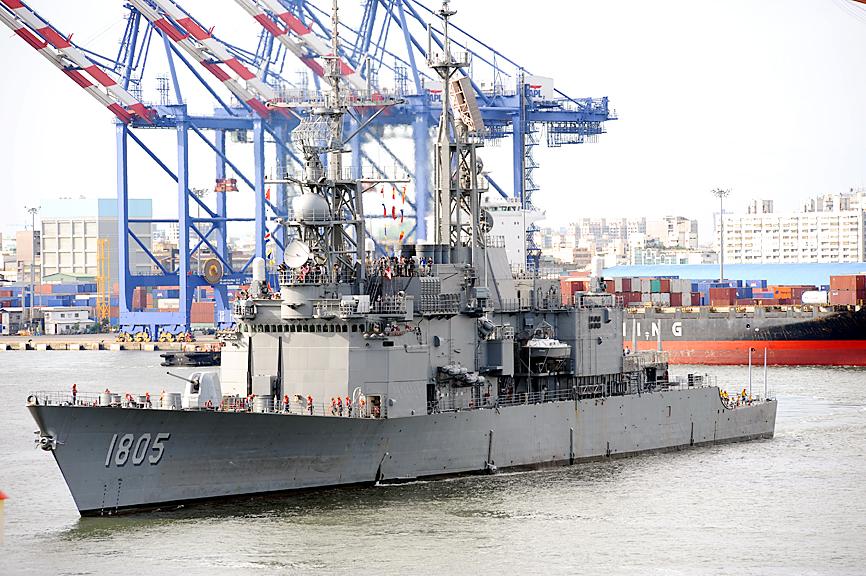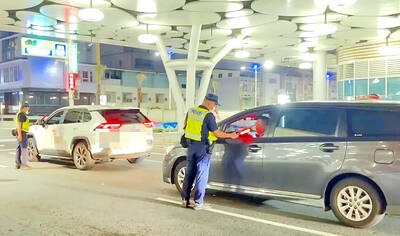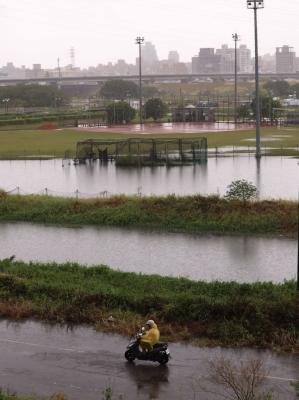China appears to have built mockups of a port in northeastern Taiwan and a military vessel docked there, with the aim of using them as targets to test its ballistic missiles, a retired naval officer said yesterday.
Lu Li-shih (呂禮詩), a former lieutenant commander in Taiwan’s navy, wrote on Facebook that satellite images appeared to show simulated targets in a desert in China’s Xinjiang region that resemble the Suao naval base in Yilan County and a Kidd-class destroyer that usually docks there.
Lu said he compared the mockup port to US naval bases in Yokosuka and Sasebo, Japan, and in Subic Bay in the Philippines, but it more closely resembles Suao.

Photo: Chang Chung-yi, Taipei Times
The South China Morning Post on Thursday quoted Lu as saying that the mockup vessel resembled one that was based in northeast Taiwan and some Guam-based US vessels.
“The mockups and drills suggest that Chinese People’s Liberation Army warships are simulating precision strikes on the Guam naval base and the Suao military port using China’s YJ-21 anti-ship missiles,” the newspaper quoted him as saying.
“A site with full-scale piers and a destroyer-sized ship-like target was constructed in December [last year],” said a report published on Wednesday on the US Naval Institute Web site, an independent forum.
“A test missile hit ... dead-center on the ship replica in February” at the Taklamakan Desert site and the target was quickly disassembled “and is now gone,” the Web site reported.
In November last year, satellite images showed that China was building targets that simulated a US aircraft carrier and other US warships in the desert to test its hypersonic anti-ship ballistic missiles, including YJ-21s, which are an increasingly significant threat to vessels, it said.
Images of the sites were in satellite images that the US Naval Institute posted, but it did not name any structures that the mockups might have been modeled after.

TRAFFIC SAFETY RULES: A positive result in a drug test would result in a two-year license suspension for the driver and vehicle, and a fine of up to NT$180,000 The Ministry of Transportation and Communications is to authorize police to conduct roadside saliva tests by the end of the year to deter people from driving while under the influence of narcotics, it said yesterday. The ministry last month unveiled a draft of amended regulations governing traffic safety rules and penalties, which included provisions empowering police to conduct mandatory saliva tests on drivers. While currently rules authorize police to use oral fluid testing kits for signs of drug use, they do not establish penalties for noncompliance or operating procedures for officers to follow, the ministry said. The proposed changes to the regulations require

Taipei, New Taipei City, Keelung and Taoyuan would issue a decision at 8pm on whether to cancel work and school tomorrow due to forecasted heavy rain, Keelung Mayor Hsieh Kuo-liang (謝國樑) said today. Hsieh told reporters that absent some pressing reason, the four northern cities would announce the decision jointly at 8pm. Keelung is expected to receive between 300mm and 490mm of rain in the period from 2pm today through 2pm tomorrow, Central Weather Administration data showed. Keelung City Government regulations stipulate that school and work can be canceled if rain totals in mountainous or low-elevation areas are forecast to exceed 350mm in

EVA Airways president Sun Chia-ming (孫嘉明) and other senior executives yesterday bowed in apology over the death of a flight attendant, saying the company has begun improving its health-reporting, review and work coordination mechanisms. “We promise to handle this matter with the utmost responsibility to ensure safer and healthier working conditions for all EVA Air employees,” Sun said. The flight attendant, a woman surnamed Sun (孫), died on Friday last week of undisclosed causes shortly after returning from a work assignment in Milan, Italy, the airline said. Chinese-language media reported that the woman fell ill working on a Taipei-to-Milan flight on Sept. 22

1.4nm WAFERS: While TSMC is gearing up to expand its overseas production, it would also continue to invest in Taiwan, company chairman and CEO C.C. Wei said Taiwan Semiconductor Manufacturing Co (TSMC) has applied for permission to construct a new plant in the Central Taiwan Science Park (中部科學園區), which it would use for the production of new high-speed wafers, the National Science and Technology Council said yesterday. The council, which supervises three major science parks in Taiwan, confirmed that the Central Taiwan Science Park Bureau had received an application on Friday from TSMC, the world’s largest contract chipmaker, to commence work on the new A14 fab. A14 technology, a 1.4 nanometer (nm) process, is designed to drive artificial intelligence transformation by enabling faster computing and greater power